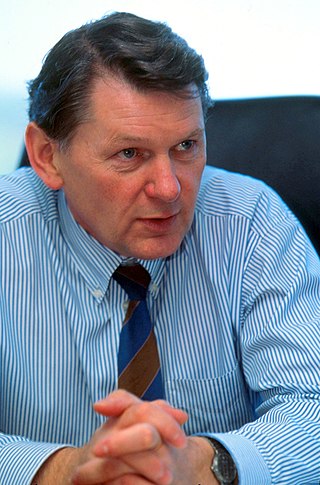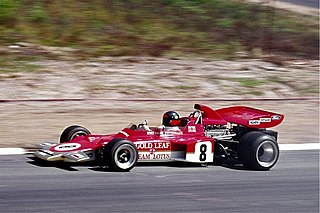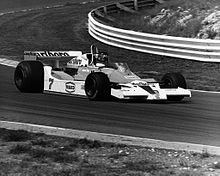McLaren Racing Limited is a British motor racing team based at the McLaren Technology Centre in Woking, Surrey, England. The team is a subsidiary of the McLaren Group, which owns a majority of the team. McLaren is best known as a Formula One chassis constructor, the second-oldest active team and the second-most successful Formula One team after Ferrari, having won 187 races, 12 Drivers' Championships, and eight Constructors' Championships. McLaren also has a history in American open wheel racing as both an entrant and a chassis constructor, and has won the Canadian-American Challenge Cup (Can-Am) sports car racing championship.

Renault, a French automobile manufacturer, has been associated with Formula One as both team owner and engine manufacturer for various periods since 1977. In 1977, the company entered Formula One as a constructor, introducing the turbo engine to Formula One with its EF1 engine. In 1983, Renault began supplying engines to other teams. Although the Renault team had won races, it withdrew at the end of 1985. Renault engines continued to be raced until 1986.

James Simon Wallis Hunt was a British racing driver who won the Formula One World Championship in 1976. After retiring from racing in 1979, Hunt became a media commentator and businessman until his death.

Formula One automobile racing has its roots in the European Grand Prix championships of the 1920s and 1930s, though the foundation of the modern Formula One began in 1946 with the Fédération Internationale de l'Automobile's (FIA) standardisation of rules, which was followed by a World Championship of Drivers in 1950.

John Edward Barnard, is an English engineer and racing car designer. Barnard is credited with the introduction of two new designs into Formula One: the carbon fibre composite chassis first seen in 1981 with McLaren, and the semi-automatic gearbox with shift paddles on the steering wheel, which he introduced with Ferrari in 1989.

The 1973 Canadian Grand Prix was a Formula One motor race held at Mosport Park on 23 September 1973. It was race 14 of 15 in both the 1973 World Championship of Drivers and the 1973 International Cup for Formula One Manufacturers.

The 1976 Spanish Grand Prix was a Formula One motor race held at the Circuito del Jarama in Madrid, Spain on 2 May 1976. The race was the fourth round of the 1976 Formula One season. The race was the 22nd Spanish Grand Prix and the sixth to be held at Jarama. The race was held over 75 laps of the 3.404-kilometre circuit for a total race distance of 255 kilometres.

The 1977 Austrian Grand Prix was a Formula One motor race held at the Österreichring on 14 August 1977. It was the twelfth race of the 1977 World Championship of F1 Drivers and the 1977 International Cup for F1 Constructors.

Satoru Nakajima is a Japanese former racing driver. He is a five-time Japanese Top Formula champion, and was the first full-time Japanese Formula One driver. Accordingly, he is responsible for several firsts for Japanese drivers in Formula One, including being the first to score championship points, and being the first to record a fastest lap.

Team Lotus was the motorsport sister company of English sports car manufacturer Lotus Cars. The team ran cars in many motorsport categories including Formula One, Formula Two, Formula Ford, Formula Junior, IndyCar, and sports car racing. More than ten years after its last race, Team Lotus remained one of the most successful racing teams of all time, winning seven Formula One Constructors' titles, six Drivers' Championships, and the Indianapolis 500 in the United States between 1962 and 1978. Under the direction of founder and chief designer Colin Chapman, Lotus was responsible for many innovative and experimental developments in critical motorsport, in both technical and commercial arenas.

The Lotus 72 is a Formula One car designed by Colin Chapman and Maurice Philippe of Lotus for the 1970 Formula One season. The 72 was a pioneering design featuring inboard brakes, side-mounted radiators in sidepods, and aerodynamic wings producing down-force.

The McLaren M23 was a Formula One racing car designed by Gordon Coppuck, with input from John Barnard, and built by the McLaren team. It was a development of the McLaren M16 Indianapolis 500 car. A Ford Cosworth DFV engine was used, which was prepared by specialist tuning company Nicholson-McLaren Engines. This helped push the DFV's horsepower output to around 490 bhp.

The McLaren MP4/5, and its derived sister model, the McLaren MP4/5B, were highly successful Formula One racing cars designed by the McLaren Formula One team based in Woking, England, and powered by Honda's naturally-aspirated RA109E and RA100E V10 engines respectively. The chassis design was led by Neil Oatley, teaming up with Steve Nichols, Pete Weismann, Tim Wright, Bob Bell and Mike Gascoyne. As with the previous designs, Gordon Murray, as Technical Director, had the role of liaising between the drawing office and production. Osamu Goto was the Honda F1 team chief designer for the car's engine.

The McLaren M2B was the McLaren team's first Formula One racing car, used during the 1966 season. It was conceived in 1965 and preceded by the M2A development car. Designed by Robin Herd, the innovative but problematic Mallite material was used in its construction. The car was powered by Ford and Serenissima engines but both lacked power and suffered from reliability issues.

The McLaren M7A and its M7B, M7C and M7D variants were Formula One racing cars, built by McLaren and used in the world championship between 1968 and 1971. After two relatively unsuccessful years of Formula One competition, the M7A was used to score McLaren's first win at the 1968 Belgian Grand Prix.
BS Fabrications was an engineering company specialising in fabrications for Formula One teams founded by Bob Sparshott, a former engineer at Lotus who had worked with Jim Clark and Graham Hill, and John 'Ace' Woodington in Luton in 1972. The company also ran a number of private F1 cars for customers in Grand Prix racing between 1972 and 1978.

The Lotus 102 was a Formula One racing car designed by Lotus for use in the 1990 Formula One season and would eventually go on to compete in 37 races spanning three seasons from 1990 until 1992.

The McLaren M28 is a Formula One racing car built and run by McLaren in the 1979 Formula One World Championship. Powered by a naturally-aspirated Ford Cosworth 3-litre engine, the M28 was designed and wind tunnel tested during the latter half of 1978.

The McLaren M19A is a Formula One racing car built and run by McLaren in three World Championship seasons between 1971 and 1973. The C version was used in the 1972 and 1973 seasons.

The McLaren MCL32 is a Formula One racing car designed and constructed by McLaren to compete in the 2017 FIA Formula One World Championship. The car was driven by two-time World Drivers' Champion Fernando Alonso, who stayed with the team for a third season; and Stoffel Vandoorne, who joined the team after Jenson Button retired from full-time competition at the end of the 2016 season.



















